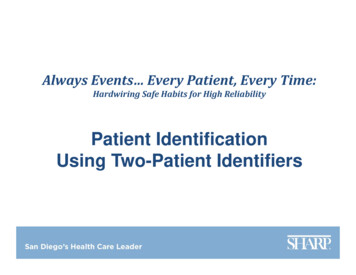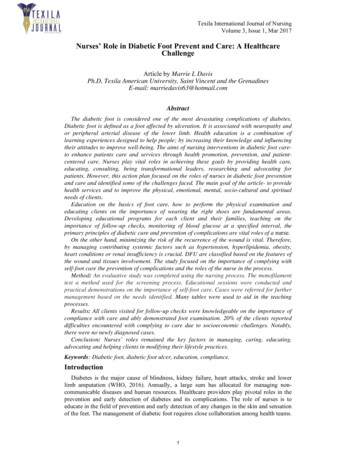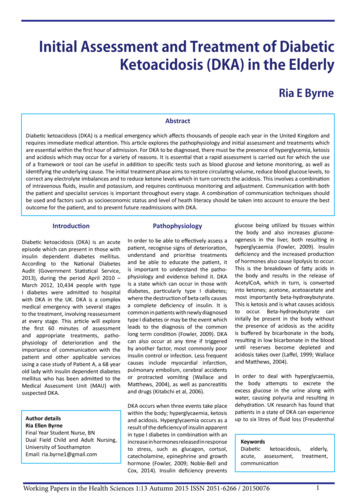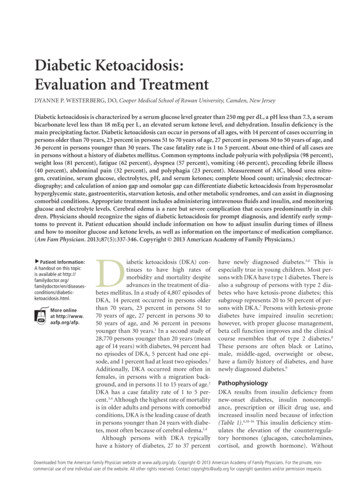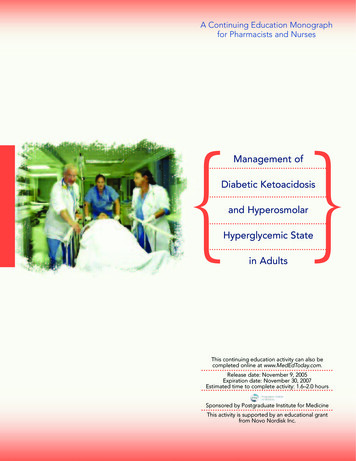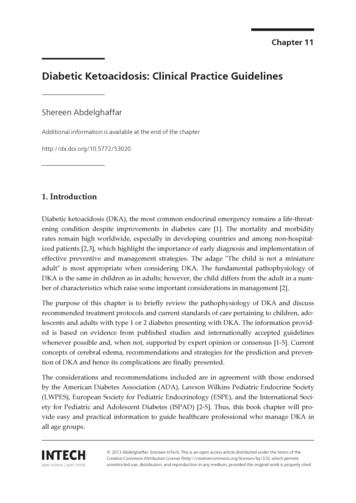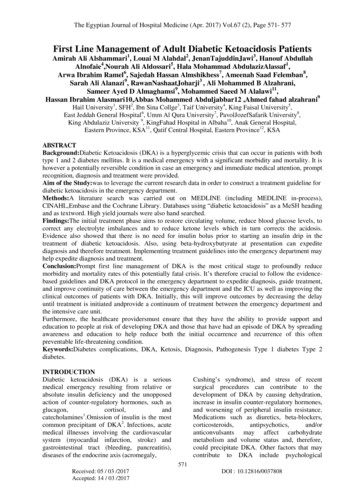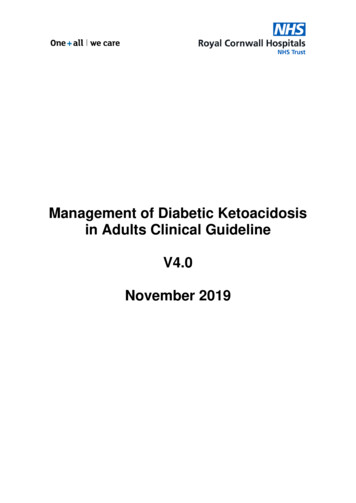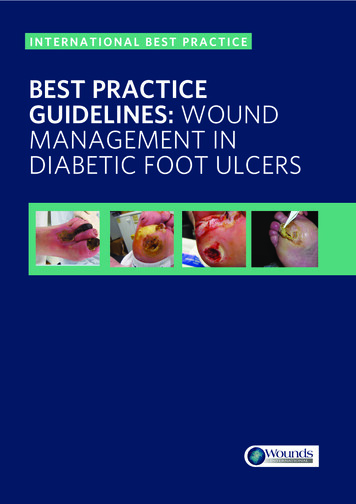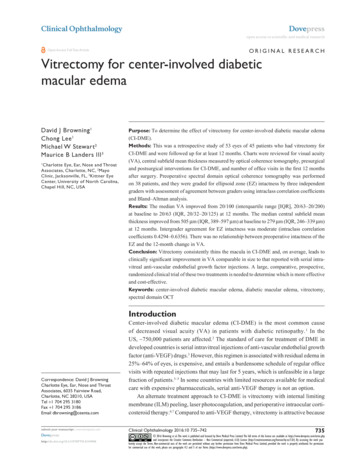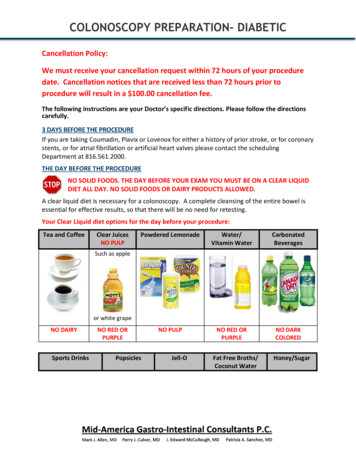
Transcription
Lower Extremity Ulcers andAmputation as Complicationsof Diabetes:Role of the interdisciplinarywound team and woundcenters:HYPERBARIC WOUND AND EDEMA CENTERFORT HEALTHCARE
LE ulcers and amputationas complication ofdiabetes: Medicalaspects:ROBERT GOLDMAN, MD, CWS-P; MEDICAL DIRECTOREpidemiology Amputationrate over past twodecades is down. Number of people with diabetes haveincreased. Slight reduction in number ofamputations
Lower incidence diabetes-relatedcomplications1990 - 201060% diabetic leg amputations1990- 2010
But prevalence of diabetesincreasing: Little net decreaseAnd 5 year mortality after legamputation still exceeds 50%
Cause of foot ulcers: Progressivesensory, motor and autonomic loss. Dying back neuropathy. Foot deformities. Pressure areas Foot ulcers. Disease process: Neuropathy.
Peripheral arterial disease Distal more than proximal. Small vessel disease. Nitric Oxide mediated.Patterns of arterial insuffiency Proximal disease HTN Smoking Distal disease Diabetes Endstage renal disease
Small vessel diseaseO3NO. Immune problems WBCdecreasedphagocytosis. Decreasedability to fightinfection.
Opportunities for early intervention,Primary Care Higher A1c associated with more severe complications, more quickly. Often associated with smoking. Other opportunities for improved adherencePreventive care
Wagner Scale for Diabetic Foot Ulcers: Wagner 1: Surface ulcer Wagner 2: Break fascial plane, no infection. Wagner 3: Break fascial plane, infection (cellulitis and/orosteomyelitis. Wagner 4: GangreneWagner 1
Wagner 3Wagner 4
Treatment paradigms. Neuropathic disease—off loading PAD – revascularization. Mixed disease: both off loading and revascularizationWagner I and II: Interdisciplinary care bestpracticed in comprehensive wound centers. Focus on local wound care Skin substitutes Treatment of infection. Off loading. DH Walker TCC
Optimizing Outcomes Wound Care Team Coordinated caregives best chance ofsuccess Goodcommunication, in apatient-centeredsystem ensures betteroutcomes at lowercostDifficult to achievein a single providerpractice 2010 by Diversified Clinical Services, Inc. All rights reservedWhy refer to a WCC WCCs can provideeasier access toadvanced technology 2010 by Diversified Clinical Services, Inc. All rights reserved
Why refer to a WCC WCCs can provide better accountability to patients, providers,and payers 2010 by Diversified Clinical Services, Inc. All rights reservedWagner III and IV: Limb preservation:heal or turn major amputation into minorone. Plan: wound care, rehab, surgical, infectious disease, vascular,hyperbaric Revascularization has become commonplace. Treatment of osteomyelitis. Podiatric or Orthopedic surgery at the foot level.
Team management: Withinwound center. Wound physician, nursing, rehabilitation Surgical evaluation for debridement of bone orminor amputation. Podiatric surgery Ortho foot and ankle. Vascular specialist: Revascularization. Osteomyelitis; Infectious diseaseGrowth ofWound Care Centers & HBOT1988-2010 2010: 2500 centers nationwide 600 partnership of wound management organizationand hospitals Remainder “free standing” Centers profitable Growth 7%-8% per year over past 20 yearsMonitoring the Changing Wound Care Clinic.Caroline Fife and Dot Weir, Today’s Wound Clinic,July/August 2011
Hospital Discharge rates for PADand ulcers decreased in US19902010Hyperbaric oxygen and limbpreservation. Treatment of Wagner III and IV: This is a CMS approved indication: HBOT center for Diabetic foot ulcers: Closest is Fort Healthcare. Dane County: There is HBOT, but is not for CMS approvedapplications
DFU: Hyperbarics improves odds of savinglimb.Favors HBOT
HBOT improves healing of DFU Randomized, double blinded, sham-controlled trial N 94 patients with Wagner 2, 3, 4 for 3 months; Most Wagner 3. Intent to treat At one year: 52% healed in HBOT group and 29% in sham control group. For 35 treatments: 61%/27%Londahl, M., P. Katzman, et al. (2010). "Hyperbaric oxygen therapy facilitateshealing of chronic foot ulcers in patients with diabetes." Diabetes Care 33(5):998-1003.Level “A” evidence: Improveddiabetic healing with HBOT
Benefit is Limb preservation,Risks include: Pressure (Barotrauma) Ear Eye Lung Oxygen toxicity Heart CNS
Conclusion Diabetes complications includes wound and limb loss.Rate improved 60% over last three decades. Diabetes leads to wounds and infection due tovascular, neuropathic, immune, pressure factors. Reduce incidence wounds: Better diabeticmanagement, including foot exams, shoes. Reduce amputations: Wound centers. Wagner I, II: Wound centers. Wagner III, IV: Wound surgical revasc, ID, HyperbaricsMortality in diabetes is high but does not have toinclude major limb lossIdentifying & EducatingThe Diabetic PatientPENNY SULLIVAN RN, CWON
Identify People At Risk Loss of protective sensation. Lower extremity arterial disease. History of previous ulcers or amputation. Poor diabetes control, HgbA1c 9. Greater than 10 yrs with diabetes. Smoking. Visual abnormalities. Elevated planter pressure, abnormal gait. Foot deformities Rigid foot deformity.Education Wash feet daily with lukewarm water ( 110 ). Dry feet well especially between toes. Moisturize feet daily with fragrance and alcohol freelotion, do not apply between toes. Change socks daily. Always wear shoes, even in the house. Do not use heating pads, water bottles, or electricblankets.
Education Shoes with large toe box and adequate cushioning. Check feet daily for blisters, callus, wounds, cracks. Examine shoes before donning. Quit smoking and exercise. REPORT ANY FOOT ABNORMALITIESEducation Signs and Symptoms of Infectionin Chronic Wound Redness Swelling Increase drainage Increase pain Increase warmth No decrease in wound sizeChronic wound may only exhibit 1 of these signs wheninfected!!!
Alleviate Fears Explain to patient & family interventions the MD mayperform. Debridement Topical lidocaine Pain medication 45-60 minutes before appointmentBecause treating an DMwound takes amultidisciplinary team, it canbe overwhelming.Topical Treatments Dressing the wound Where to get dressings Insurance FinancesCan the patient dress the wound Dexterity Support system Mental ability Home health support
Education Off loading of the wound TCC Creative dressing Off loading boots DH walkerDebunking Old Treatments My mother always said Clean wounds with peroxide Leave wounds open to air Scabs are good, means the wound is healing Soaking with Epson salt
A Day in The Life ofan HBO PatientTRICIA ABENDROTH, CHTInitial encounter Overview on approvedand Unapprovedmaterials in the chamberAddress Patient concerns
Treatment Day Whatto expect Barotrauma prevention Blood sugars & insulindependent patientsTreatment specifications Depth& number oftreatments Air breaks and OxygenToxicity In Chamber TCOM
The personal touch Warmand invitingenvironment Getting to know thepatients Working as a family inwound care
Plan: wound care, rehab, surgical, infectious disease, vascular, hyperbaric Revascularization has become commonplace. Treatment of osteomyelitis. Podiatric or Orthopedic surgery at the foot level. Team management: Within wound center. Wound physician, nursing, rehabilitation Surgical evaluation for debridement of bone or minor amputation. Podiatric surgery Ortho foot and ankle. Vascular .

